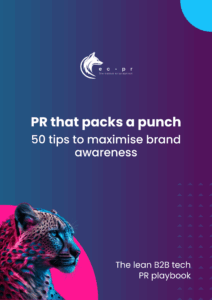How do you become an industry influencer? You are already an expert in your field, but becoming a industry influencer and thought leader is considered the holy grail of PR and marketing. It’s when you’re called by the BBC News to be an expert on a breaking story, when the most respected industry trade magazine calls you for your opinion and when you’re asked to speak at those all-important industry events.
But in this noisy world where everyone has an opinion, how do you become a thought leader? How do you elevate yourself and the brand you represent, with your own clear, well thought out viewpoint?
The initial stages to becoming and staying an industry influencer is taking the time to thoroughly research and formulate your thoughts before communicating them with the media. Follow our tried and tested steps to get you started:
STAGE 1: RESEARCH THE 5 BE’s
BE PASSIONATE
Focus on something you are passionate about. You must genuinely love your subject. If you care, you will come across as authentic and credible. To remain current, you will need to keep abreast of the latest thinking relating to your area of expertise – reading widely is an essential practice for a thought leader as is talking to other experts to fine tune your opinions.
BE INFORMED
Research your area properly so that you are informed on different possible perspectives.Consider topical issues, those in the news – for example; climate change, autonomous ships and piracy, and develop your opinion on them. Writing and news reporting is rarely impartial, so think about what the motivation might be behind the various documented opinions you read.
BE EVIDENCE DRIVEN
Evaluate which angles have the most merit, and document these. Having looked at the main options, consider the evidence that the opinions are based on. Draw up a list of evidence the writers refer to and evaluate which you think is the most robust and persuasive. Which do you find the most compelling?
BE OPINIONATED
Develop your opinion with appropriate proof points.As you develop your opinions, remember to keep detailed notes and annotate your text so that you can keep track of where your influences have come from. Depending on the material format you produce, you may need to quote sources.
BE VISUAL
Create visual representations of your idea.Wherever possible, create models, illustrations, infographics or even cartoons to bring your ideas to life. If you struggle with this, find someone who can help you. Remember, different people engage with, and absorb, information in different ways; by using graphics you can simplify complex concepts, increasing your chances of engaging with more people.
KNOW YOUR AUDIENCE
It’s critical to be clear about who you want to engage with because this will inform the tone and intellectual level you need to adopt in your language, content and presentation style. For example, the BBC News traditionally broadcasts news stories in a way that an average 14-year old can understand – this means researchers and interviewers drill down to the essence of a story, sometimes appearing to oversimplify it in order to make it accessible to its broad audience. Other media organisations will have a different approach or style.
STAGE 2: FORMULATE
PULL TOGETHER YOUR THOUGHTS IN A ‘THINK PIECE’
With the information you have researched, draft a minimum of 100 words on each of the points below… alternatively, you can record your thoughts into a voice recorder. Ask yourself the following questions:
- Why do you care about this?
- Why should your audience care about?
- What facts/developments do they need to be aware of?
- What common assumptions/mistakes are made when trying to deal with this and why are they wrong?
- Can you provide some examples of good and bad practices… – names, case studies, more names!
- How do you propose this issue could be approached? Identify your evidence for suggesting this could work.
- Map out the resistance you anticipate to your proposal, quote naysayers. Explain why you believe these naysayers to be wrong.
- Summarise what you expect to achieve if your approach is followed.
- Draft your introduction… and your conclusion.
NEARLY DONE…
Once you have your 1000+ words, take your draft to a colleague or your PR company, to review and provide constructive comment. For your key ‘Think Piece’, do not aim for a word count. You are aiming to produce a thoroughly researched, well argued, interestingly composed opinion that will provoke responses in thought, word or deed. And when you have done that – stop.
With your Think Piece done, your next challenge is to get your opinions out there! To get you started download out guide on How to Become an Industry Thought Leader, and then make sure your thought leadership isn’t wasted, it needs to be promoted. This is where your PR team can help you become an industry influencer. Get in touch with us today!



